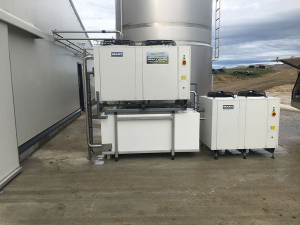Dairy farmers planning to upgrade or install new milk cooling plant must think long-term rather than install a ‘bare minimum’ system.
Luxmore Farm, at Waipahi, South Otago, took that approach.
Owner Gerard Vallely engaged Waikato Milking Systems and Cowley Electrical Dairy and Pumps to install the farm’s new dairy plant which included a 60-bail Orbit concrete rotary parlour and a milk cooling system.
WMS had its Gore and Balclutha dealer Cowley Electrical Dairy and Pumps install the milk cooling system. Cowley’s Balclutha manager, Jared Cowley, led the project with WMS’s head of milk cooling NZ, Craig Gibbons.
Cowley says the milk cooling system is specifically designed for Luxmore Farm and is a model for others to follow.
He says the company can design milk cooling systems tailored specifically for a farm.
“At Luxmore we installed two Tank chiller units, one on each of the two milk silos at the farm.”
The cooling units are capable of heat recovery, removing heat so they work more efficiently. Hot water can then be put back into the hot water cylinder at 55-60 deg C.
One unit runs the base refrigeration of the large tank and a smaller unit services the side wall of the large tank to cool the milk during peak milk flows. When the side wall cooling is not needed the unit can be used to cool calf milk in the smaller silo.
“The smaller silo is designed to be used at the start of the season for cooling calf milk,” Cowley said. “More customers are looking to cool their calf milk so it lasts longer.”
He says the calf milk can be cooled at a temperature determined by the farmer. When calving is finished, the silo can be washed out and reconfigured to store supply milk.
“The main advantage is the ability to use that silo for two different purposes, and two different times of the year, fully utilising the equipment on farm.”
The Luxmore cooling system was installed before the start of the 2019-2020 milking season.
Cowley had one refrigeration engineer and a stainless fitter work on the project.
He says efficiency and longevity are two key factors farmers in any new milk cooling system.
“It’s always important to look at what could change in the future. Don’t just go for a system which is the bare minimum.
“You need some redundancy in there so you’ve got capacity for any changes to regulations or increases in production volumes.”
Cowley says having the right information during the planning stages of a project is important to ensure an efficient system.
“That comes back to Craig and I providing the right info to the farmer, so we can deliver the correct specifications and options.”
Installing a data logger on a farm’s existing milk cooling system provides a picture of how well it is working, Cowley says.
“First of all, we can use a temperature probe on the milk inlet to the silo to get a temperature reading of the milk entering the existing system.
“We can put another probe on the water going into the plate cooler, to measure the water temperature. And we can put a probe on the silo to show us how quickly the unit is cooling the silo.
“From those three readings we can determine what needs to be done to improve.”
Cowley says farmers are aware of the need to comply with milk cooling regulations, “but there is a lot of information out there and some of it not in the best interest of farmers”.
“DairyNZ, Fonterra, your own dairy co-op - they are best placed to give you the right information to understand what the regulations are and the implications for your farm.”


















